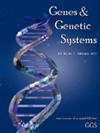小鼠生殖细胞发育过程中DNA甲基化的动态染色质景观和机制。
IF 1
4区 生物学
Q4 BIOCHEMISTRY & MOLECULAR BIOLOGY
引用次数: 2
摘要
包括DNA甲基化(DNAme)在内的表观遗传标记在基因和反转录转座子的转录调控中起着至关重要的作用。在人类的不孕症、印记疾病和先天性疾病中检测到DNAme缺陷,突出了这种表观遗传标记在发育和疾病中的广泛重要性。虽然终分化细胞中的DNAme在细胞分裂后通过维持DNAme机制稳定地繁殖,但这种表观遗传标记的广泛清除和随后的重新建立发生在胚胎发育早期和生殖细胞发育中。结合深度测序,过去几年开发的低输入方法已经能够在包括发育中的生殖细胞在内的罕见细胞群体中实现DNAme和组蛋白翻译后修饰(PTMs)的高分辨率和全基因组定位。使用这些新方法的表观基因组研究揭示了生殖细胞发育过程中动态染色质景观的前所未有的观点。此外,对正常生殖细胞和缺乏染色质修饰酶的生殖细胞中染色质标记的综合分析揭示了组蛋白PTMs与生殖细胞中新生DNAme之间的关键相互作用。本文综述了在小鼠生殖细胞中DNAme的清除及其新生机制方面的研究工作,以及生殖细胞中染色质动态格局调控方面的悬而未决的问题。本文章由计算机程序翻译,如有差异,请以英文原文为准。
The dynamic chromatin landscape and mechanisms of DNA methylation during mouse germ cell development.
Epigenetic marks including DNA methylation (DNAme) play a critical role in the transcriptional regulation of genes and retrotransposons. Defects in DNAme are detected in infertility, imprinting disorders and congenital diseases in humans, highlighting the broad importance of this epigenetic mark in both development and disease. While DNAme in terminally differentiated cells is stably propagated following cell division by the maintenance DNAme machinery, widespread erasure and subsequent de novo establishment of this epigenetic mark occur early in embryonic development as well as in germ cell development. Combined with deep sequencing, low-input methods that have been developed in the past several years have enabled high-resolution and genome-wide mapping of both DNAme and histone post-translational modifications (PTMs) in rare cell populations including developing germ cells. Epigenome studies using these novel methods reveal an unprecedented view of the dynamic chromatin landscape during germ cell development. Furthermore, integrative analysis of chromatin marks in normal germ cells and in those deficient in chromatin-modifying enzymes uncovers a critical interplay between histone PTMs and de novo DNAme in the germline. This review discusses work on mechanisms of the erasure and subsequent de novo DNAme in mouse germ cells as well as the outstanding questions relating to the regulation of the dynamic chromatin landscape in germ cells.
求助全文
通过发布文献求助,成功后即可免费获取论文全文。
去求助
来源期刊

Genes & genetic systems
生物-生化与分子生物学
CiteScore
1.50
自引率
0.00%
发文量
22
审稿时长
>12 weeks
期刊介绍:
Genes & Genetic Systems , formerly the Japanese Journal of Genetics ,
is published bimonthly by the Genetics Society of Japan.
 求助内容:
求助内容: 应助结果提醒方式:
应助结果提醒方式:


